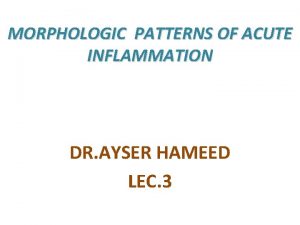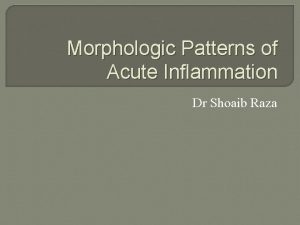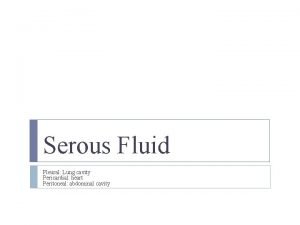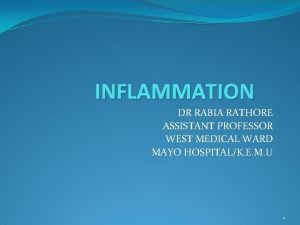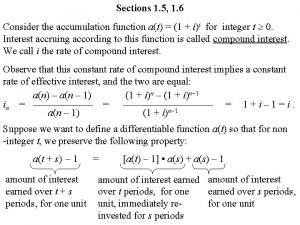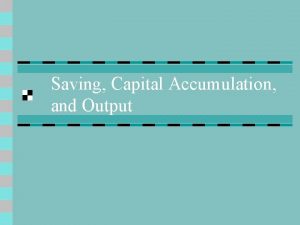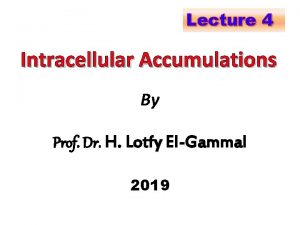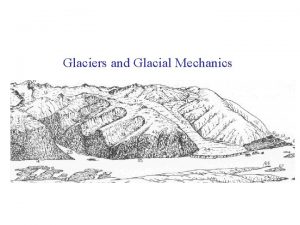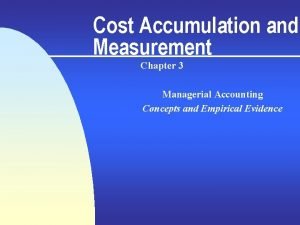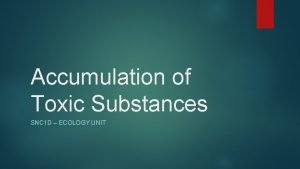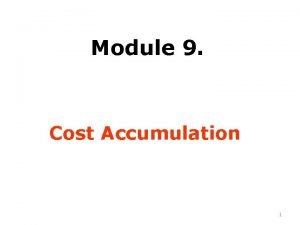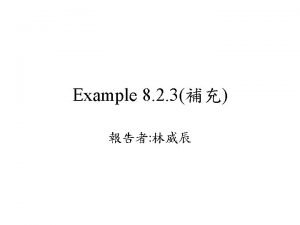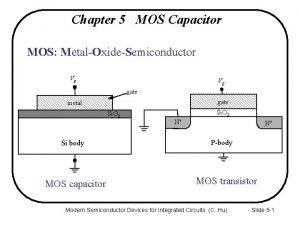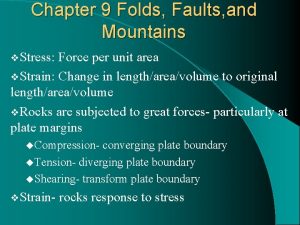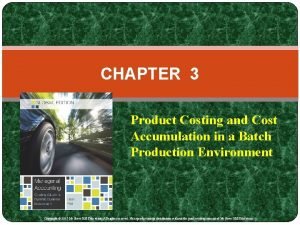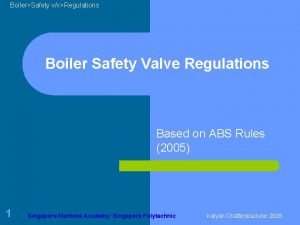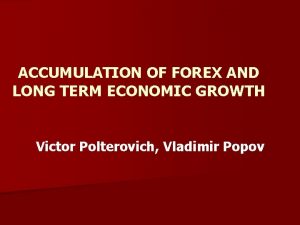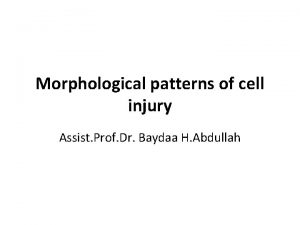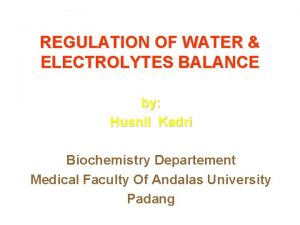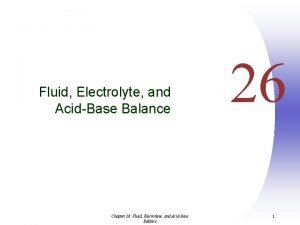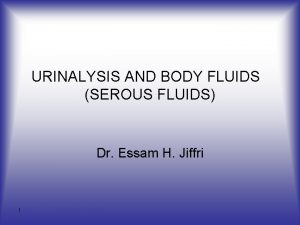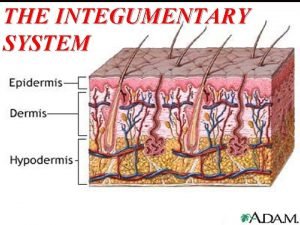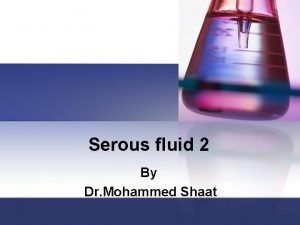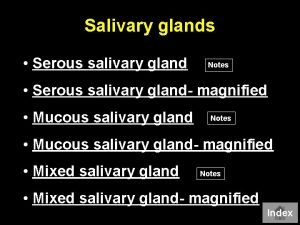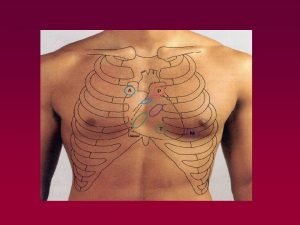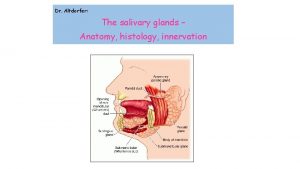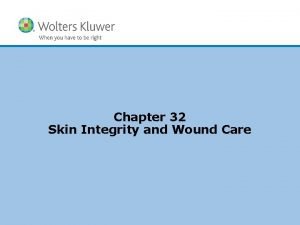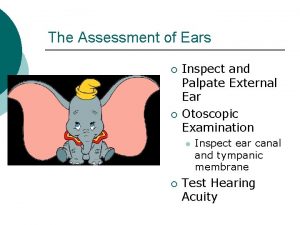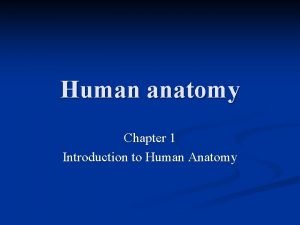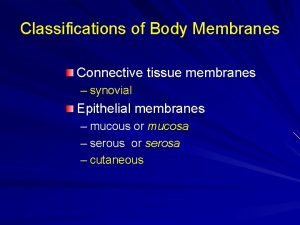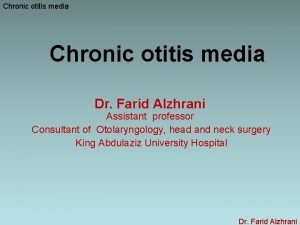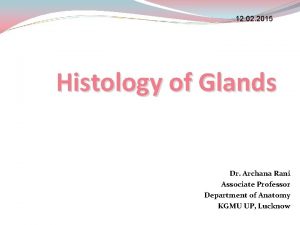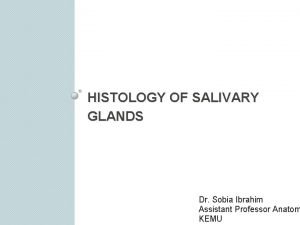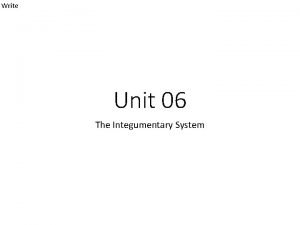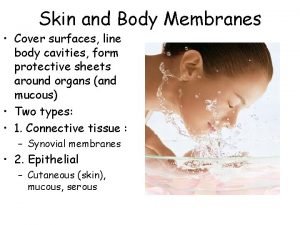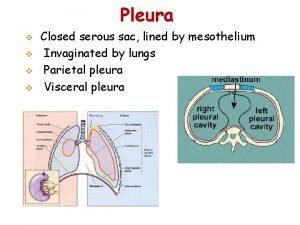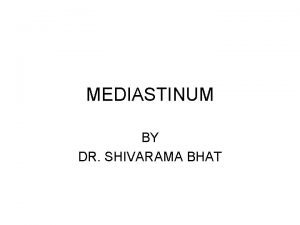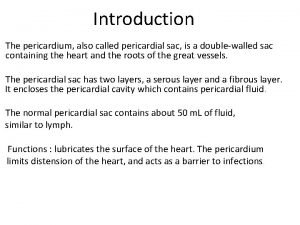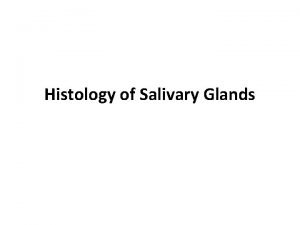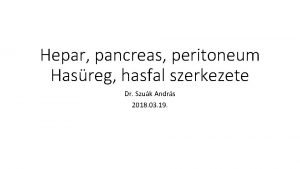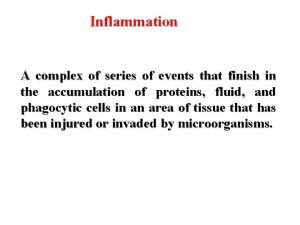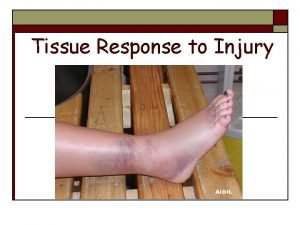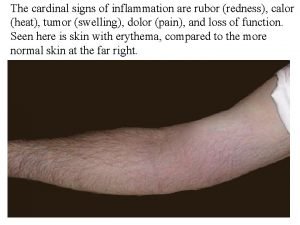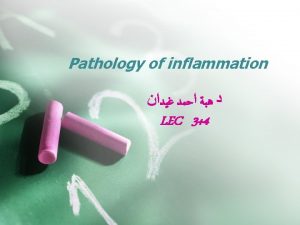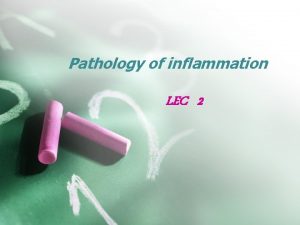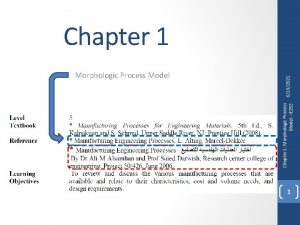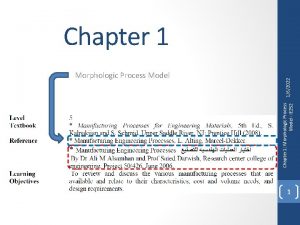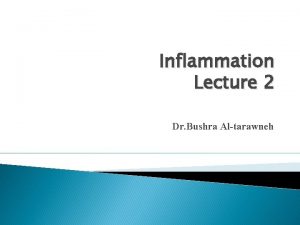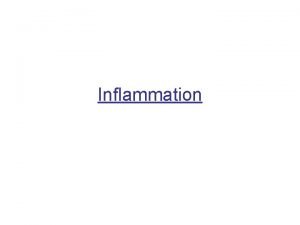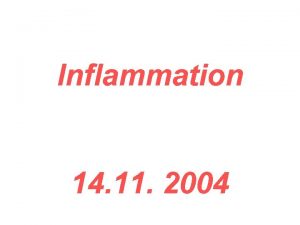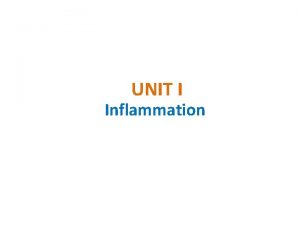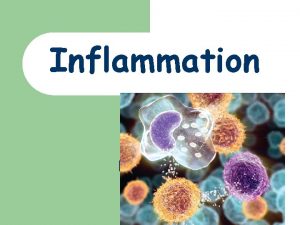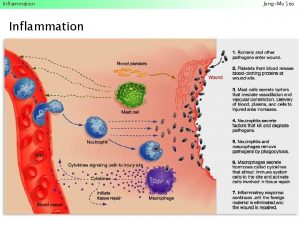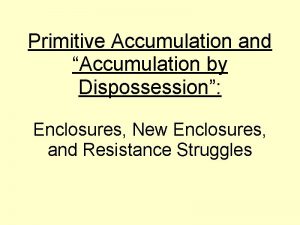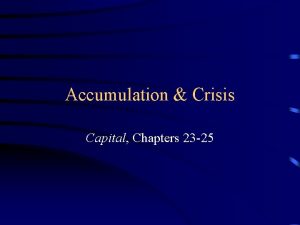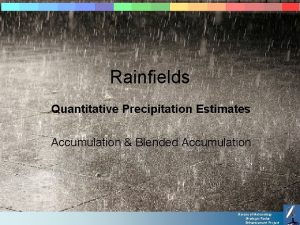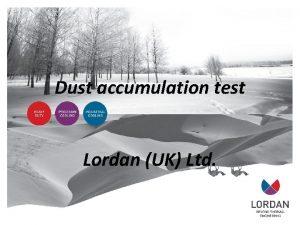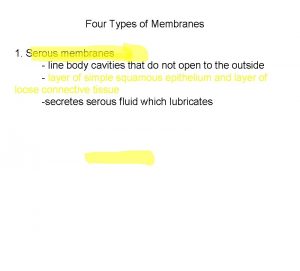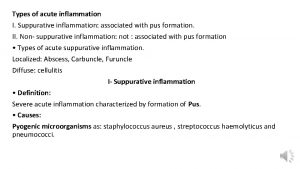Morphologic types of inflammation Serous inflammation accumulation of

































































- Slides: 65



Morphologic types of inflammation Serous inflammation浆液性炎 accumulation of excessive serous fluid (clear watery fluid) with variable protein content (plasma) n Locus: mucous membrane, connective tissue, skin serosa, loose n Manifestation: inflammatory edema, blister, cavity effusion, serous catarrh n Sequel: absorption

Serous inflammation a friction blister of the skin

Serous inflammation right pleural effusion in a baby serous effusion clear, pale yellow appearance of the fluid

Morphologic types of inflammation Fibrinous inflammation 纤维素性炎 以纤维蛋白原渗出为主,继而形成纤维蛋白,即纤维素 • • Definition : The inflammation exudate contains plentiful fibrinogen, then forms fibrin. Cause: severe vascular injury—bacterial toxin,Hg, urea Locus: mucous membrane, serosa, lung Manifestation: Pseudo-membranous inflammation--dysentery, diphtheria rheumatic pericarditis---Hairy heart(绒毛心) lobar pneumonia


Fibrinous inflammation 纤维素性炎 bacillary Dysentery 细菌性痢疾

Fibrinous inflammation 纤维素性炎

Fibrinous inflammation 纤维素性炎 绒毛心 Hairy heart Shaggy heart Cor villosum

Fibrinous inflammation 纤维素性炎 绒毛心 Hairy heart

normal fibrinous pericarditis纤维素性心包炎

Fibrinous inflammation 纤维素性炎 lobar pneumonia 大叶性肺炎

Fibrinous inflammation 纤维素性炎 Outcome o Absorption: lobar pneumonia o Organization and adherence -- pericarditis--armored heart(盔甲心) --Pulmonary Carnification(肺肉质变) p Pseudo-membrane: detach—ulcer, bleeding trachea diphtheria—asphyxia

Fibrinous inflammation 纤维素性炎 Pulmonary Carnification 肺肉质变 心包腔闭锁 心包壁层和脏层发生纤维性粘连

Morphologic types of inflammation Suppurative inflammation 化脓性炎 以中性粒细胞渗出为主,伴不同程度组织坏死和脓液形成 n The presence of large number of neutrophils and varying degrees of tissue necrosis and pus formation. n Pus—purulent exudation n Purulent cells—degenerated and necrotic neutrophils Causes: pyogenic bacteria superficial suppuration and Empyema(表面化脓和积脓) Phlegmonous inflammation(蜂窝织炎) Abscess (脓肿)

Types of suppurative inflammation Superficial Suppuration and Empyema 表面化脓和积脓 n Superficial Suppuration Location: mucosal or serosa surface Features: Pus formation, Suppurative Catarrh n Empyema a collection of pus in a hollow viscus, e. g. in the gallbladder or fallopian tube, serous cavity

Superficial Suppuration 表面化脓性炎 化脓性脑膜炎acute meningitis

Superficial Suppuration 表面化脓性炎 化脓性腹膜炎purulent peritonitis

Empyema 积脓 输卵管积脓pyosalpinx 心包腔积脓 purulent exudate in pericardial cavity

Types of suppurative inflammation Phlegmonous inflammation 蜂窝织炎 疏松结缔组织的弥漫的化脓性炎 n Definition: wide-spread purulent inflammation in loose tissue n Locus: skin, muscle and appendix n Causes: hemolytic streptococci 溶血性链球菌:透明质酸酶,链激酶

Phlegmonous inflammation 蜂窝织炎 Phlegmonous inflammation: in loose tissue

Phlegmonous inflammation 蜂窝织炎 acute appendicitis 急性阑尾炎

Types of suppurative inflammation Erysipelas(丹毒) An acute disease of the skin and subcutaneous tissue caused by a species of hemolytic streptococcus and marked by localized inflammation and fever Also called: Saint Anthony's fire 丹毒是皮肤及其网状淋巴管的急性化脓性真皮炎。病原菌是 A族乙型溶血性链球菌,好发于下肢和面部。其临床表现为 起病急,局部出现界限清楚之片状红疹,颜色鲜红,并稍隆 起,压之褪色。皮肤表面紧张炽热,迅速向四周蔓延,有烧 灼样痛。伴高热畏寒等。

Types of suppurative inflammation Abscess 脓肿 局限性化脓性炎症,其主要特征是组织发生溶解坏死,形 成充满脓液的腔 p Definition--Focal localized collections of purulent inflammatory tissues caused by suppuration buried in a tissue, an organ, or a confined space. p Locus--skin, lung, brain, liver, kidney p Causes— Staphylococcus aureus 金黄色葡萄球菌 毒素→组织坏死→PMN浸润→PMN崩解释放蛋白水解酶→坏死组织液化 血浆凝固酶→纤维蛋白原转变为纤维素→病变局限 层粘连蛋白受体→迁徙性脓肿

Abscess 脓肿 Liver abscess

Abscess 脓肿 Renal abscess

Lung abscess

Localized suppurative inflammation of haircyst, 疖 Furuncle sebaceous gland & surrounding tissues. 痈 Carbuncle: Fusion of quite a few furuncles. 疖 Furuncle 痈 Carbuncle

Haemorrhage inflammation出血性炎 Inflammation associated with conspicuous haemorrhage as a result of vascular damage. 血管损伤重,大量红细胞漏出 流行性出血热(epidemic hemorrhagic fever) 钩端螺旋体病(leptospirosis) 鼠疫(plague) 炭疽(anthrax) 炭疽性脑膜炎


Events in the complete resolution of inflammation 1. Return to normal vascular permeability 2. Removal of fluid and protein 3. Macrophage pinocytosis 4. Phagocytosis by neutrophils 5. Necrotic debris by macrophages 6. Eventual exodus by macrophages


炎症局部蔓延(local spreading) 溃疡Ulcer


Course & outcome of Inflammation p Local spreading p Lymphatic spreading: 淋巴管炎lymphangitis, 淋巴结炎lymphnoditis p Blood spreading l 菌血症 Bacteremia: organisms→ blood l 毒血症 Toxemia: toxin→ blood l 败血症 Septicemia: ①+② l 脓毒败血症 Pyaemia: pyogenic organisms








Course & outcome of Inflammation Chronic inflammation Injur y Acute inflammation healing spread regional Lymphatic Blood vessel

Section 3 chronic inflammation

Causes of chronic inflammation o supervening on acute 继发于急性炎症之后 o due to repeated bouts of an acute 急性炎症反复发作 at beginning: o persistent infection by intracellular microorganisms (tubercule bacilli-- Granulomatous inflammation ) n Prolonged exposure to nondegradable but potentially toxic substances (silicosis in the lung) n Immune reactions perpetuated against the individual’s own tissues (rheumatoid arthritis,SLE) n

Types of Chronic inflammation p Non –specific chronic inflammation 一般慢性炎症 p Chronic Granulomatous inflammation 慢性肉芽肿性炎症

Pathologic features of general chronic inflammation Non-special chronic inflammation Ø Exudation: manifest of active inflammation Ø Inflammatory cells: macrophage, lymphocytes, and plasma cells. Ø Alteration: Tissue destruction-mainly caused by inflammatory cells ØProliferation: parenchymal cells, vessels and connective tissues

Non-special chronic inflammation Chronic bronchitis慢性支气管炎

Non-special chronic inflammation Here is chronic cervicitis. Appearance of more mononuclear cells. In this case the inflammation is severe enough to produce mucosal damage with hemorrhage.

Chronic inflammation 炎性息肉(inflammatory polyp) :由局部粘膜上皮、腺体及肉芽 组织增生所致。常见于鼻、子宫颈、肠 o Polypoid lesion of mucosa result from Chronic inflammation composed of mucosal glands, granulation tissue, and inflammatory cells. o Commonly seen in nasal, cervical & colorectal mucosa. 炎性息肉—鼻息肉

Chronic inflammation 炎性假瘤(inflammatory pseudotumor):炎性增生形成的肉眼和 Ⅹ线观察上与肿瘤相似的团块。常见于眼眶、肺 o Tumor-like proliferation of local tissues (parenchymal, stromal, even inflammatory cells) resulting from chronic inflammation o It is not a real tumor o Occur in the orbit, lung, liver and spleen 炎性假瘤

Chronic granulomatous inflammation 慢性肉芽肿性炎 A form of chronic inflammation is characterized by granulomas-small nodular collections of activated macrophages. 慢性肉芽肿性炎是以肉芽肿形成为特点的特殊慢性炎症。肉 芽肿是由巨噬细胞及其衍生细胞局部增生构成的境界清楚的 结节状病灶。 l Special type of chronic inflammation l Distinctive pattern (granuloma) l Aggregation of macrophages (derived cell) l Diameter 0. 5 -2 mm

causes of granulomas p Infective granuloma Bacteria—结核,麻风 l treponema螺旋体—梅毒 l fungi 真菌 l parasite寄生虫 l p Foreign body’s granuloma p Agnogenic:

Conditions of granulomas formation Two conditions : 1. Durable chronic stimulation 2. 异物肉芽肿 3. 2. Cellular immune response 4. 结核

Infective granuloma Tuberculosis • Caseous necrosis • Epitheloid cells and Langhans giant cell • Lymphocytes • fibrosis

Infective granuloma Langhans giant cells and epitheloid cells

Foreign body’s granuloma Features: foreign bodies Foreign body giant cells: seen in association with particulate insoluble material. Nuclei scattered throughout cytoplasm.

Foreign body’s granuloma Here is a foreign body type giant cell at the upper left of center adjacent to a segment of vegetable material aspirated into the lung

Foreign body’s granuloma Two foreign body giant cells are seen just to the right of center where there is a bluish strand of suture material from a previous operation

Two types of granulomas Infection granulomas Foreign body granulomas

Causes and outcomes of acute and chronic inflammation



Thanks for your attention! Contact me: E-mail: lee 5019@hotmail. com Tel: 13504310416 医乃仁术 学海无涯
 Morphological patterns of inflammation
Morphological patterns of inflammation Morphologic patterns of acute inflammation
Morphologic patterns of acute inflammation Morphological patterns of acute inflammation
Morphological patterns of acute inflammation Serous fluid
Serous fluid Serous inflammation examples
Serous inflammation examples Cost accumulation and cost assignment
Cost accumulation and cost assignment Accumulation function
Accumulation function Capital accumulation
Capital accumulation Cost accumulation and cost assignment
Cost accumulation and cost assignment Principal math definition
Principal math definition Examples of intracellular accumulation
Examples of intracellular accumulation Arête glacier
Arête glacier Cost pools
Cost pools Cost accumulation
Cost accumulation Intracellular accumulation
Intracellular accumulation What is a period cost on the income statement
What is a period cost on the income statement Whats bioaccumulation
Whats bioaccumulation Direct vs indirect expenses
Direct vs indirect expenses Parking study in traffic engineering
Parking study in traffic engineering Accumulation point of a sequence
Accumulation point of a sequence Dose individualization definition
Dose individualization definition Mosfet accumulation depletion inversion
Mosfet accumulation depletion inversion Tension geology
Tension geology Manufacturing overhead cost
Manufacturing overhead cost Boiler accumulation test
Boiler accumulation test Forex accumulation
Forex accumulation Cell injury and inflammation
Cell injury and inflammation An atypical accumulation of fluid in the interstitial space
An atypical accumulation of fluid in the interstitial space An atypical accumulation of fluid in the interstitial space
An atypical accumulation of fluid in the interstitial space European credit transfer and accumulation system
European credit transfer and accumulation system Transudate vs exudate
Transudate vs exudate Serous drainage
Serous drainage Exudative ascites
Exudative ascites Serous fluid
Serous fluid Ducts vs glands
Ducts vs glands Visceral layer
Visceral layer Mucous acini
Mucous acini Serosanguineous vs serous
Serosanguineous vs serous Inspect the external auditory canal
Inspect the external auditory canal Sekret serous mata adalah
Sekret serous mata adalah Tympanosclerosis
Tympanosclerosis Serous membrane
Serous membrane Connective tissue membranes
Connective tissue membranes Tubotympanic
Tubotympanic Cefdinir medscape
Cefdinir medscape Simple branched alveolar gland
Simple branched alveolar gland Vesicouterine pouch function
Vesicouterine pouch function Serous vs mucous glands
Serous vs mucous glands Serous drianage
Serous drianage Respiratory mucosa
Respiratory mucosa Cutaneous membrane
Cutaneous membrane Costomediastinal line
Costomediastinal line What is mediastinum
What is mediastinum Parietal layer of serous pericardium
Parietal layer of serous pericardium Mucus salivary gland
Mucus salivary gland Serous membrane
Serous membrane Serous diffuse myocarditis
Serous diffuse myocarditis Factors delaying wound healing
Factors delaying wound healing Types of inflammation
Types of inflammation Trigeminal neuralgia
Trigeminal neuralgia Cardinals signs of inflammation
Cardinals signs of inflammation Cardinal sign of inflammation
Cardinal sign of inflammation Morphological patterns of acute inflammation
Morphological patterns of acute inflammation Acute inflammation
Acute inflammation Non odontogenic infection
Non odontogenic infection Stages of inflammation
Stages of inflammation

